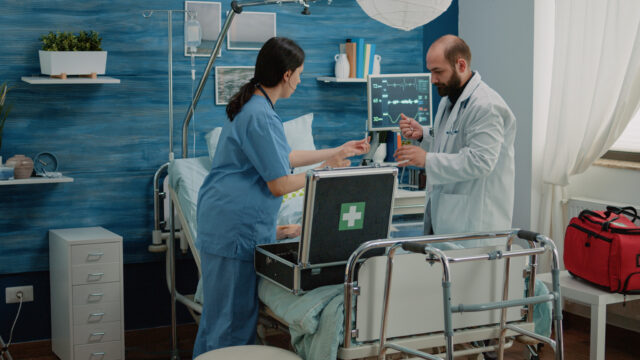In modern healthcare, where the margin for error is razor-thin and every moment can be life-altering, one often overlooked factor plays a critical role in the patient care ecosystem: the reliability of hospital equipment. Behind every successful diagnosis, surgery, or emergency response lies a network of machines—each one needing to function flawlessly, every time.
But what happens when equipment fails without warning? The consequences can be devastating: delayed treatment, increased patient risk, lost revenue, and reputational damage.
This is where predictive maintenance (PdM) emerges as a transformative solution—empowering hospitals to move from reactive problem-solving to proactive performance.
What is Predictive Maintenance?
Predictive Maintenance is an advanced maintenance strategy that uses real-time data, artificial intelligence (AI), and machine learning (ML) to anticipate when medical equipment is likely to fail. Rather than fixing machines after a failure occurs or performing routine checks regardless of actual condition, PdM forecasts equipment health based on usage patterns, environmental conditions, and historical performance.
In essence, it allows hospitals to fix what needs fixing—right before it breaks.
How Does It Work?
The implementation of predictive maintenance involves several technological layers:
1. IoT-Enabled Sensors
Small, intelligent sensors are embedded into medical devices. These sensors monitor key performance indicators (KPIs) like:
- Temperature
- Vibration
- Electrical current
- Humidity
- Usage hours
2. Data Transmission & Storage
The data from these sensors is continuously streamed to a centralized platform, often cloud-based, where it is stored and processed.
3. AI-Powered Analytics
Advanced algorithms analyze the incoming data in real-time to:
- Detect deviations from normal operating conditions
- Identify early warning signs of wear or failure
- Calculate Remaining Useful Life (RUL) of each component
4. Automated Alerts & Workflows
When anomalies are detected, maintenance teams are automatically notified. This enables scheduled interventions before breakdowns happen—without disrupting hospital operations.
Why Predictive Maintenance Matters in Healthcare
Hospitals are vastly different from manufacturing plants or office buildings—failures here affect human lives. The stakes are higher, and so are the benefits of staying ahead of the curve.
1. Reduced Downtime of Critical Equipment
Ventilators, infusion pumps, MRI scanners, anesthesia machines—these are not optional devices. Downtime can delay procedures, reduce patient capacity, and create care bottlenecks.
Predictive maintenance ensures critical systems remain operational with up to 50% reduction in unexpected failures.
2. Cost Optimization
Emergency repairs often cost 3-9x more than scheduled maintenance. With PdM:
- Parts can be replaced in advance
- Fewer technician call-outs are needed
- Equipment lifespan increases by 20-40%
Hospitals can reinvest these savings into patient care or innovation.
3. Improved Patient Safety
Inconsistent machine performance can lead to misdiagnosis, improper dosing, or outright danger during surgeries. Predictive maintenance helps ensure that:
- Monitors show accurate vitals
- Imaging equipment delivers precise results
- Life-support systems operate reliably under pressure
4. Compliance & Accreditation
Regulatory bodies (e.g., Joint Commission, FDA) require documentation of medical equipment maintenance. PdM platforms automatically log every service, anomaly, and update, simplifying compliance.
Real-World Example: A Case in Action
St. Mercy Regional Hospital, a 700-bed facility in the Midwest, implemented a predictive maintenance pilot on 120 infusion pumps and ventilators.
Results in 6 Months:
- 70% reduction in unplanned maintenance events
- $240,000 saved in repair and labor costs
- Zero downtime in ICU equipment
- Improved patient throughput in ER by 12%
The hospital is now expanding the program to imaging and diagnostic departments.
Steps to Implement Predictive Maintenance in Hospitals
Transitioning from traditional maintenance to predictive models requires a thoughtful rollout. Here’s a simplified roadmap:
- Asset Audit: Identify critical equipment and existing maintenance schedules.
- Sensor Integration: Retrofit machines with IoT sensors or acquire new PdM-ready devices.
- Platform Deployment: Choose a PdM platform with analytics, alerting, and dashboard capabilities.
- Data Training: Feed historical data to refine prediction models.
- Pilot & Scale: Start small, track KPIs, and scale across departments.
Tip: Collaborate with vendors who understand healthcare regulatory environments and offer clinical-grade reliability.
The Bigger Picture: Sustainability and Smart Hospitals
Predictive maintenance isn’t just about fixing machines—it’s part of a broader vision of Smart Hospitals:
- Fewer spare parts = reduced waste
- Energy-efficient operations
- Better resource allocation
- Integration with digital twins and hospital management systems
It’s where technology meets human care—with precision.
Final Thoughts
Predictive maintenance isn’t just a tech buzzword—it’s a lifesaving innovation. By adopting this approach, hospitals can drastically reduce downtime, optimize budgets, comply with regulations, and—most importantly—improve the quality of care.
In a sector where seconds matter and reliability is everything, predictive maintenance might be one of the most impactful upgrades a hospital can make.







